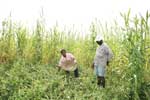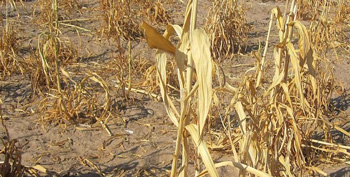
Communal farmer harvest bumper mahangu crop

Johannes Keshongo harvesting cowpea also known as Omakunde in his mahangu plot at Omuntele. (Photograph courtesy of CLUSA)
The Baseline for the current yield of Namibia’s staple food cultivated by approximately 160,000 subsistence farmers is lower than 300 kg per hectare, according to a United Nations Joint Programme and FAO baseline study of 2009.
Keshongo is applying Conservation Tillage farming technique, an agricultural preparation of the soil by mechanical agitation of various types, such as digging, stirring, and overturning. When tilling in this way, a ripper and furrower is used to plough the land. The ripper cracks the hard surface open along the furrow line without disturbing the lanes in between furrows. This allows a deep root development which forms ridges of 30 cm between the ripped planting lines that create an in-field water harvesting effect guiding rain water to the plants.
Conservation Tillage is increasingly replacing conventional ploughing methods such as disc harrowing and ploughing. It is a method within the wider concept of Conservation Agriculture which involves practicing minimum soil disturbance, maximum soil cover and crop rotations in order to reverse soil degradation, increase soil fertility and soil water holding capacity.
Keshongo’s bumper harvest came as a result of early land preparation, planting with the first rain, thinning seedlings and applying a mixture of manure and fertilizer. “I prepared my land early and planted first week of November 2012 after having received a heavy rain. It rained on and off until end of December, but since January this year, I have only received scattered showers. However, the soil moisture in the ripped lines is still high,”says Keshongo.
He added that the mahangu roots in the ripped lines have further developed to a depth of 48 cm. “I apply fertilizer and manure in the ripped lines only, thus saving on input compared to the conventional method where I used to spread the fertiliser,” he said.
Using indigenous seed carefully selected from the best performing plants, Keshongo has been practicing Conservation Tillage and crop rotations for the past three years and saw that the tractor rips and furrows the same lines year after year. He also rotates mahangu and cowpea to increase soil fertility.
‘I noticed that my yields were increasing therefore I expanded to 5 hectares using the ripping and furrowing technique. Now I will put my entire farm of 7 hectares under Conservation Tillage,” he added. According to Keshongo, following his successful harvest, his neighbours have now shown interest in the same technique. Ripping and furrowing land preparation can be done throughout the dry season beginning straight after harvest, thus creating optimal planting opportunities for farmers who can then plant with the onset of rain. Keshongo’s land was ripped and furrowed by the Ministry of Agriculture, Water and Forestry and a private plough contractor.
Keshongo has been a participant in the Conservation Tillage Namibia project (CONTILL), and the Omuntele Green Project supported by the Ministry of Agriculture, Water and Forestry and UNDP-GEF Country Pilot Programme (CPP), and the UNDP GEF-SGP Community Based Adaptation to Climate Change pilot project implemented by Creative Entrepreneurs Solutions. He is currently a Lead Farmer within the Namibia Conservation Agriculture Project (NCAP) implemented by CLUSA International and financed by the USAID. As a Lead Farmer, Keshongo will train 30 aspiring conservation tillage farmers in his area for a period of one year.
According to Richard Shikongo, NCAP Coordinator for CLUSA, Keshongo’s yields are a great example of what can be achieved when Conservation Agriculture is practised. “These are proven methods that can result in yields most farmers have never dreamed of even during drought years,” Shikongo stated. Crop farming is considered to be one of the biggest sources of income for many communal farmers in the northern parts of the country and the farming activities vastly contribute to food security.










































